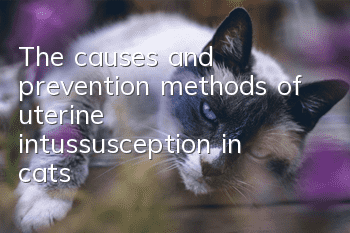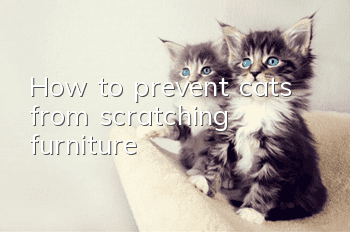The causes and prevention methods of uterine intussusception in cats!

The causes and prevention methods of uterine intussusception in cats! Every pregnancy of a pet is a test of vitality. Not only are dystocia caused by various factors threatening the pet’s life, but various postpartum complications will also affect the pet’s life. healthy. Especially elderly pets who have passed their prime reproductive period are more likely to suffer from dystocia and postpartum diseases. Last month, our hospital received an elderly common domestic cat that had just given birth. The owner described that the female cat showed obvious abdominal pain symptoms such as abdominal bowing and trembling after giving birth. After various examinations, the cat was diagnosed with postpartum uterine horns. Intussusception.
1. Animal disease conditions
An ordinary domestic cat, eight years old, has normal prenatal mental state and appetite. The cat gave birth on the afternoon of March 20 and gave birth to a litter. Three hours later, no second kitten was born. A veterinarian from another pet hospital checked that there was still a kitten in the pregnant cat’s belly. In order to help the mother cat give birth to her litter, , the pet doctor of the hospital injected the female cat with oxytocin and inserted his hand into the birth canal to pull the kitten. After about ten minutes of assisted delivery, the kitten was pulled out. The female cat is currently in poor spirits, has no appetite, has a hunched back and abdominal pain, and the birth canal is constantly leaking foul-smelling, brown secretions.
2. Overall and general examination
Lie on your back in Baoding and gently palpate the abdomen of the sick cat with your hands. The sick cat will raise its head and look at its abdomen from time to time and make painful noises. As the sick cat screams, a small amount of brown secretion flows out from the birth canal. The sick cat's eyeballs are sunken, and the conjunctiva and oral mucosa are light red. The body temperature is 40 degrees Celsius, the respiratory rate is 35 times/min, and the pulse rate is 144 times/min. Upon auscultation, the cat had an irregular heartbeat and absent bowel sounds.
1. Abdominal palpation: The sick cat is placed in a right-lying position. The examiner uses both hands to palpate from the left and right abdominal walls of the sick cat. There is a solid object about three finger widths between the hands that looks like a sausage. , the sick cat screamed in pain, and at the same time a large amount of foul-smelling brown contents flowed out of the birth canal.
2. Vaginal exploration, hold the sick cat in front and back, clean the vulva of the sick cat with pet vaginal cleaning solution, disinfect the right hand, insert the index finger of the right hand into the birth canal for inspection, and use the left hand to move the uterus from the lower abdomen to the pelvis Squeeze gently at the entrance. Only one index finger can pass through the cervix. Continue to extend your right index finger forward into the uterine cavity for inspection. There is no fetus in the uterine cavity, but there is a large amount of liquid content; continue to extend your right index finger. The patient entered the uterine horn for examination and found that the right uterine horn was normal and there was a solid object in the left uterine horn. When touched with the left hand from the outside, the solid object looked like a sausage. The initial diagnosis may be uterine intussusception.
3. Laboratory tests
1. Blood test
After blood collection, blood routine and blood biochemical tests will be carried out. The values are basically within the normal range. It is judged that because the onset time is short, bacterial infection of the birth canal has not yet been caused.
2. Sampling and examination of birth canal secretions
DeliverySmear and staining of excreta were carried out, and a small amount of Staphylococcus aureus was found in the final microscopic examination. It shows that there is no obvious infection in the birth canal.
IV. Instrumental examination
Finally, through B-ultrasound and X-ray examination, it was confirmed that the cat had postpartum uterine intussusception.
5. Treatment measures
There are generally two types of treatment measures for postpartum uterine intussusception in cats: conservative treatment and surgical treatment. Considering that the cat’s uterine intussusception is serious and there is a possibility of recurrence even with timely conservative treatment, we decided to perform surgical treatment with the owner’s consent.
1. Preoperative preparation
(1) Infusion of 5% GS, adenosine triphosphate, COA, and Vc during the operation;
(2) Right side of the sick cat Lying on the side in Baoding; using the left abdominal wall as the surgical entrance, the surgical site was trimmed and shaved, disinfected with iodophor, and the wound was isolated; local anesthesia was performed with 0.5% procaine hydrochloride.
(3) Surgical instruments: Conventional obstetric surgical instruments such as scalpels, surgical scissors, and hemostats must be sterilized by high-temperature steam.
(4) Preparation and disinfection of surgical personnel: Soak and disinfect the arms with 0.1% chlormethionine solution.
2. Surgical process
The skin and subcutaneous tissue are incised, the abdominal wall muscles are separated, and the peritoneum is incised using a reverse lift to expose the abdominal cavity. Perform abdominal exploration to elicit sausage-like organs: Insert the index and middle fingers of your left hand into the abdominal cavity for exploration, and pull the sausage-like organs out of the incision. If the left uterine horn is found to be intussusceptive, measure the intussusceptive uterine horn. It was three centimeters long and two centimeters in diameter, with a small amount of congestion and weak uterine contractions. Hold the left uterine horn near the fallopian tube with your right hand, hold the intussuscepted uterine horn near the uterine body with your left hand, and gently pull outward with your right hand. After many gentle pulls, the intussuscepted uterine horn can be reset. Oxytocin is injected into the uterine wall at multiple points, the uterine wall is flushed with warm saline, and the uterus is returned to the abdominal cavity. Perform spiral sutures on the peritoneum and abdominal wall muscles; suture nodules on the skin and organize the skin wound edges. Use a 5% iodine tincture cotton ball to disinfect the skin incision and tie a knot with a bandage. The operation is over.
3. Postoperative care
After the operation, infusions were given for three consecutive days to prevent and treat infection, and the vagina was flushed with pet vaginal cleansing fluid. The cat was reviewed at the hospital two weeks later and the cat recovered well.
Figure 4 Vaginal douche
Figure 5 Dosage: one capful at a time
6. Summary
Cat uterine intussusception and uterine prolapse are the same pathological process, but the degree of prolapse is different. In veterinary clinical practice, intussusception and uterine prolapse can occur in various animals, especially elderly multiparous animals. They are often caused by old age and frailty, improper midwifery, such as forcibly pulling the fetus, and other factors. cause.
- What to do if the kitten is disobedient. Start training the cat to be obedient from an early age.
- What to do if a male cat in heat urinates everywhere
- What causes yellow urine in cats
- Can I deworm my cat again if there are still fleas after deworming?
- What common genetic diseases in cats do you know?
- What should I do if my cat with folded ears has diarrhea? What are the causes of diarrhea in folded-eared cats?
- Reasons why cats grind their claws and how to train cats to grind their claws in a fixed place
- Cat sneezing smells very bad
- Do cats get bored at home?
- How to clean blue cat’s ears



